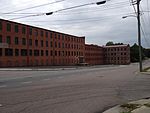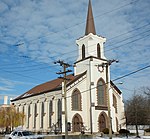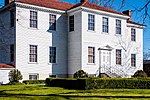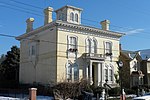William McKenney House
Central Virginia Registered Historic Place stubsHouses completed in 1890Houses in Petersburg, VirginiaHouses on the National Register of Historic Places in VirginiaNational Register of Historic Places in Petersburg, Virginia ... and 1 more
Queen Anne architecture in Virginia

William McKenney House, also known as the McKenney-Dunlop-Totty House is a historic home located at Petersburg, Virginia. It was built in 1890, and is a large 2+1⁄2-story, Queen Anne / Eastlake style townhouse. It features stained and leaded glass, elaborate pressed brickwork, terra cotta roof trim, and a circular corner tower with a conical roof.It was listed on the National Register of Historic Places in 1990, and currently serves as a public library. It is located in the Poplar Lawn Historic District.
Excerpt from the Wikipedia article William McKenney House (License: CC BY-SA 3.0, Authors, Images).William McKenney House
Guarantee Street, Petersburg
Geographical coordinates (GPS) Address Phone number Website Nearby Places Show on map
Geographical coordinates (GPS)
| Latitude | Longitude |
|---|---|
| N 37.224722222222 ° | E -77.411388888889 ° |
Address
Appomattox Regional Governor's School for the Arts and Technology
Guarantee Street
23803 Petersburg
Virginia, United States
Open on Google Maps










